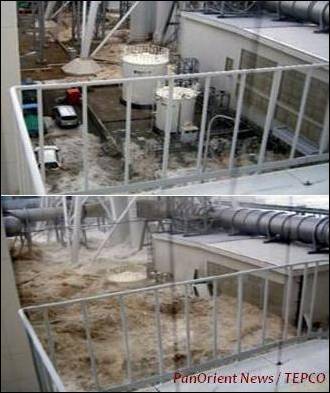|
|
Environment
March 11 Tsunami Stunned Unwary Fukushima Nuclear Plant Operators
Monday, November 28, 2011

Tokyo- (PanOrient News) Minutes after the March 11, 9.0-magnitude earthquake, the Fukushima No.1 nuclear power plant operators did not realize that tsunamis big enough to affect their operations were coming, so they decided not to accelerate reactor cooling because they thought they could control the reactor according to normal procedures, an inaction that led to the worst nuclear crisis in world history, a report by Japan's Nuclear and Industrial Safety Agency showed.
The agency, which belongs to the Ministry of Economy, Trade and Industry (METI), found this result after it recently interviewed the operators of the crippled Fukushima No.1 nuclear power plant and other experts on the situation immediately after the emergency shutdown due to the shock of the earthquake that damaged the plant.
The leading Japanese news agency, Jiji Press, disclosed parts of the agency's report which said the operators at the plant followed standard procedures – running isolation condensers to cool the No. 1 reactor and reduce the pressure inside, but the temperatures dropped considerably faster than the usual cooling speed therefore, one of the operators closed down one of the two condensers and ran the other one off and on, in order to adjust the cooling speeds.
In the central control room of the number 1 reactor, one of the operators heard that a tsunami warning had been issued but said, ”I did not realize that tsunamis big enough to affect our operations were coming." The operator also said, "I remember hearing the information, but I don't remember the anticipated arrival times or the forecast heights of coming tsunamis."
The report went on to say that operators did not accelerate reactor cooling because they thought they could control the reactor according to normal procedures when there was an automatic shutdown.
The huge tsunamis hit the plant from around 3:30 p.m. (6:30 a.m. GMT) and caused a loss of almost all power to the No. 1 reactor building. The control panel at the central control room also stopped functioning and operators lost track of the conditions of the isolation condensers.
At 6:18 p.m., power was temporarily restored so operators put the condensers back in service but they stopped them again seven minutes later because they did not know the precise levels of water in the condensers and did not want to damage the equipment. They restarted the condensers at around 9:30 p.m.
According to the report, operators said they had informed the emergency response headquarters for the Fukushima No.1 plant about the control room situations numerous times but headquarters members responded that they thought the isolation condensers would keep functioning after tsunamis which indicates that the plant staff were in confusion.
Hokkaido University Prof. Tadashi Narabayashi, one of the experts at the day's meeting, strongly advised the nuclear safety agency to investigate the situation just after the March 11 earthquake at the plant in more detail. "If the isolation condensers had been used properly, the core meltdown would not have happened," Narabayashi was quoted by Jiji as saying.
The official tsunami height prediction of the plant operator, Tokyo Electric Power Co., or TEPCO, was reportedly set at 3.1 meters when the Fukushima No. 1 nuclear plant was built in the early 1970s. But it was upgraded to the current 5.7 meters after the Japan Society of Civil Engineers (JSCE) in February 2002 established a method to evaluate tsunami heights using up-to-date simulation techniques based on a source fault model.
The central government's anti-seismic guidelines, revised in 2006, called for preparedness for earthquakes and tsunami that are "very rare but have a chance of taking place." It called on power companies to take into consideration any active fault that had slipped at least once during the past 120,000-130,000 years.
In 2009-10, TEPCO studied geological formations in Fukushima Prefecture. The utility told a scientific conference in spring this year that a tsunami would likely not have exceeded 4-5 meters above sea level because evidence of past tsunami showed no waves above that height.
TEPCO reportedly had planned to present a tsunami source model that would account for that height at a scientific meeting this autumn.
On March 11, the Fukushima No. 1 nuclear plant was swamped by a tsunami "beyond imagination," in TEPCO's words. It soared to an estimated height of 14 meters along the coast and 11.5 to 15.5 meters on land. The waves damaged pumps at a height of 4 meters, flooded 10-meter-high areas that were supposed to be safe from water, and flooded the reactor building basements that housed emergency power generators and switchboards.
Photo: March 11 tsunami sweeping Fukushima plant
PanOrient News
© PanOrient News All Rights Reserved.
|
|

